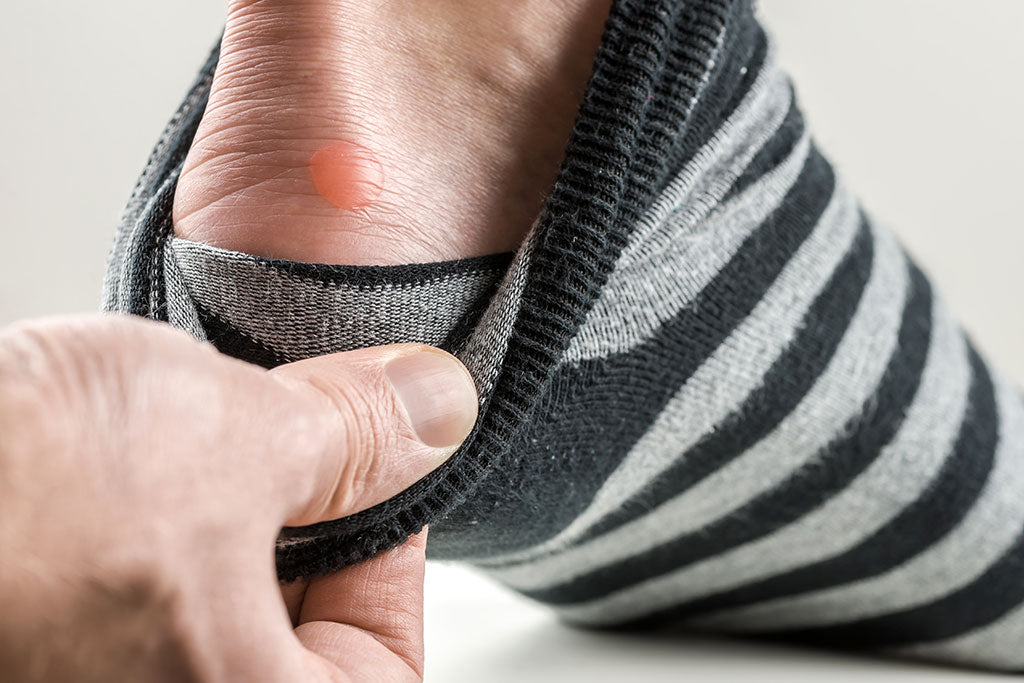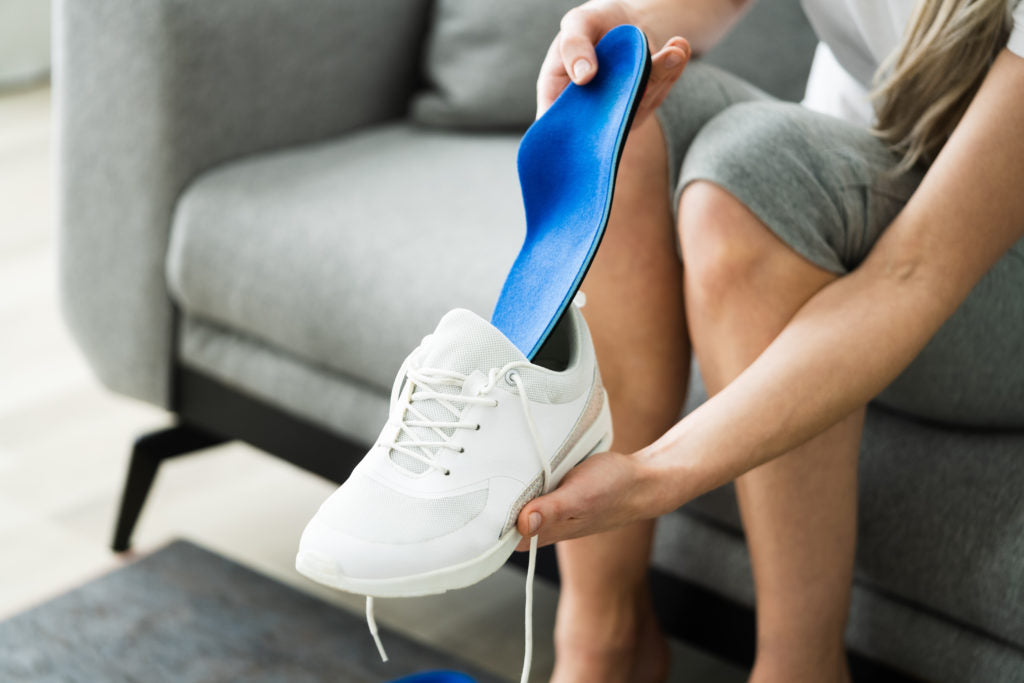
A blister is a bubble of fluid that forms beneath a thin layer of dead skin. The blister fluid is typically made up of water and proteins.
You can get blisters anywhere on the skin of your feet where there is shoe rubbing or irritation, but they’re most commonly found on the back of the heel, sides of the foot and pinky toes. Often, blisters are accompanied by discomfort or pain as they rub against shoes.
Improperly fitting shoes, and the rubbing or friction you get with them, are the main causes of blisters on feet. When your shoes rub against the skin on your foot, the resulting friction leads to the development of a friction blister. This is because the friction causes your skin layers to separate away from each other, allowing fluid (serum) to fill the separation.
Foot blisters are commonly seen in people who live an active lifestyle. You can also get blisters from vigorous activity – even when your shoes fit properly. Friction is the main factor, so any repetitive movement involving your feet can lead to blisters.
Hot or moist skin increases the force of friction, so sweaty feet can also increase the likelihood of developing a blister.

Friction blisters can be prevented by removing the cause of the friction. This includes:
• Wearing shoes that are comfortable and fit well, and gradually break-in new shoes. Keep in mind that stiffer shoes are more likely to cause blistering than a more flexible-fit shoe.
• Wearing shoes specifically designed for your activities, especially during exercise and sports
• Wearing hosiery or socks to reduce friction of your foot rubbing against your shoes, especially with new shoes or shoes that have seams or rough areas that could cause rubbing. Athletic socks that absorb moisture work best.
• Using a protective blister band aid on your foot, or inserting a protective pad in your shoe, in areas that are likely to rub and cause blisters (often used at the heel). Dr. Scholl’s Moleskin for blisters can be cut to any size and attached to your foot or to the inside of your shoe.
• Using blister sprays or balms to create a barrier on your skin and prevent chafing
Treatments tips if you have a foot blister include:
• Keeping the foot clean and dry while it heals.
• Protecting the area so the blister can heal. Use cushioning products specifically designed for blisters to help protect them so you can move more comfortably. Dr. Scholl’s® Blister Cushions with Duragel® technology are packaged in sterile form to help prevent a blister from developing an infection
• Wearing shoes that don’t rub against the blister and wearing socks with your shoes.
• For small blisters, using a regular adhesive bandage to keep the protective layer of skin over the blister intact.
• For blisters in difficult locations (e.g. the bottom of your foot) – try creating a round, donut shaped bandage around the blister. This may reduce the pressure on the blister and keep the protective layer of skin over the blister intact.
When possible, it is best to not burst, or break, the skin covering a blister. This is because blisters will often heal themselves, with the fluid slowly being absorbed back into the skin, as the skin heals. Popping a blister can increase the risk of infection, by exposing the injury to bacteria in your environment.
See your doctor if you are having trouble walking, or if you think your blister is infected. You should seek medical care if you are finding the blister very painful, and/or are having trouble walking, or if you see signs of infection. These signs can include pus on or around the blister, a spreading redness, pain, swelling, and warm skin.
How to get rid of blisters on the foot
In order to get rid of blisters on the bottom, top and back of the foot, it’s important to protect the blisters and give them time to heal. Most foot blisters go away on their own. To make foot blisters heal faster, cover the area with a protective cushion or bandage to prevent friction and irritation which can interfere with healing or cause blisters to open. While it can be frustrating to deal with foot blisters, avoid the temptation to pop them as this can increase the risk of infection.
If a blister pops, clean the area thoroughly using soap and warm water. Antibiotic ointments can be used to reduce the risk of infection. Cover the blister with a sterile bandage and replace the bandage on a daily basis until the skin has healed.
Some blisters become infected and require medical attention. Signs of infection include redness, pain and swelling. Infected blisters may also feel hot to the touch and produce a yellow, cloudy liquid.
How to treat foot blisters
To treat and heal foot blisters, it’s better to leave them alone and allow them time to resolve undisturbed. As long as they’re not causing pain, blisters shouldn’t be popped. In order to cure foot blisters and promote proper healing, avoid ill-fitted shoes that rub against the affected area. Blisters from shoes will have trouble healing if the same shoes are worn with no steps to protect the skin. To heal blisters from shoes, cover the affected skin with a blister cushion or bandage in order to prevent friction and irritation. Cushions and bandages can also be used to treat blisters from running.
To care for foot blisters that have broken open, wash the skin using warm water and soap. Consider using alcohol to disinfect or an antibiotic ointment in order to reduce the chance of an infection. Cover the skin with a sterile bandage every day while the skin has a chance to heal. To treat large foot blisters, bigger bandages and gauze may be required.
If a blister appears to be infected, consult a healthcare professional for evaluation. Infected blisters may be red and swollen, and they may be painful, hot or tender to the touch. Infected blisters may also ooze a yellow-colored liquid.
How long do blood blisters last on your foot?
Blood blisters on the foot usually last about 1-2 weeks and typically go away on their own without any special care aside from keeping the area clean.
Blood blisters on the foot should be evaluated by a healthcare professional if they don’t go away on their own or they keep coming back. A blood blister that is painful or infected should also be seen by a medical provider.
Does athlete’s foot cause blisters?
Athlete’s foot can cause blisters in some severe cases but not all cases. Blisters from athlete’s foot most commonly form on the soles of the feet and between the toes.
Should you pop foot blisters?
No, it’s best not to pop foot blisters as long as they’re not painful. In most cases, blisters heal on their own and the fluid inside is reabsorbed back into the body. Foot blisters typically heal faster with less chance of infection when they’re left undisturbed and allowed to heal without being popped.
How to prevent blisters on the arch of the foot when running
There are several ways to prevent blisters under the foot and on the arch of the foot when running.
• Wear properly fitted running shoes that stay in place. When shoes don’t fit properly, they can rub against the skin and cause blisters.
• Consider using orthotics, insoles and heel liners with shoes as these can help prevent blisters by improving the fit of running shoes and reducing friction.
• Wear moisture-wicking socks as they can help reduce the buildup of sweat which contributes to blister-causing friction. Moisture-absorbing powders and spray products can also reduce sweat.
• Apply moleskin or blister cushions to specific areas of the foot prior to running in order to protect against friction.
What to put on foot blisters
Blister cushions and bandages can be applied to foot blisters that haven’t popped. These products protect the skin from friction and help promote healing. For blisters that have popped, apply a sterile bandage after cleaning the skin thoroughly with soap and warm water. Prior to bandaging, alcohol or antibiotic ointment can be applied to reduce the chance of infection.
What causes foot blisters?
Most foot blisters are caused by friction from shoes rubbing against the skin. This can occur from shoes that don’t fit properly or from wearing a new pair of shoes all day without breaking them in first. There are other causes of foot blisters as well. For example, allergic reactions and certain types of skin infections such as athlete’s foot can cause foot blisters.
Additional Resources
• https://www.webmd.com/skin-problems-and-treatments/ss/slideshow-blisters
• https://health.clevelandclinic.org/5-ways-to-avoid-blisters-and-the-best-ways-treat-them/
• https://www.healthline.com/health/infected-blister#symptoms
• https://www.medicalnewstoday.com/articles/319799
• https://www.mayoclinic.org/diseases-conditions/athletes-foot/symptoms-causes/syc-20353841#:~:text=Athlete’s%20foot%20(tinea%20pedis)%20is,causes%20itching%2C%20stinging%20and%20burning
• https://www.health.harvard.edu/staying-healthy/athletes-foot-causes-prevention-and-treatment
• https://www.healthline.com/health/blisters-on-feet#causes
• https://www.webmd.com/skin-problems-and-treatments/understanding-athletes-foot-symptoms
• https://www.webmd.com/first-aid/blisters-treatment


